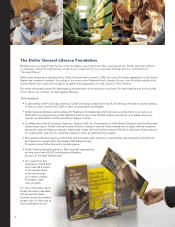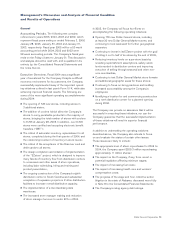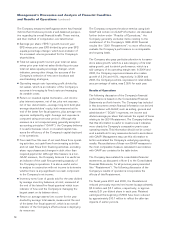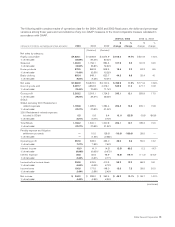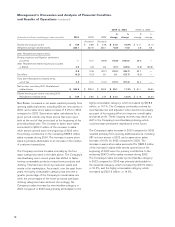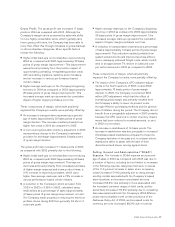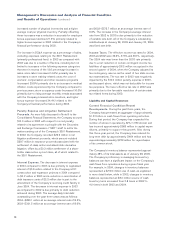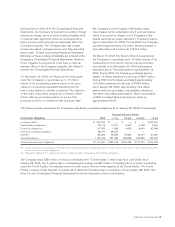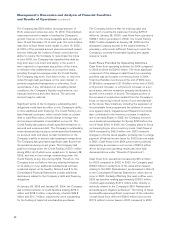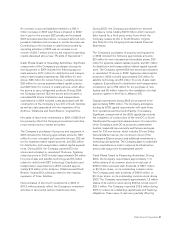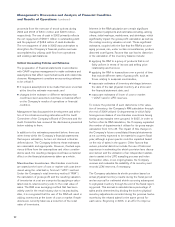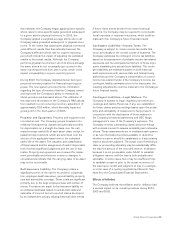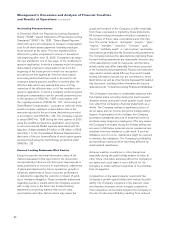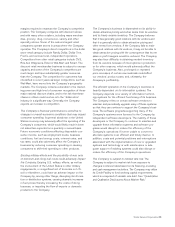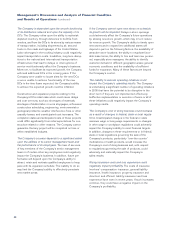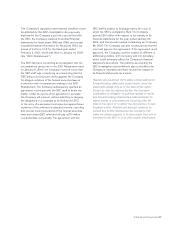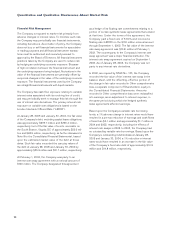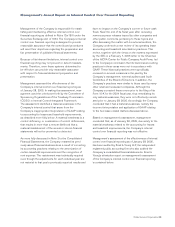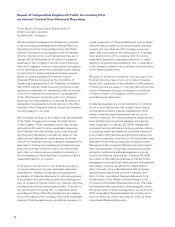Dollar General 2004 Annual Report Download - page 22
Download and view the complete annual report
Please find page 22 of the 2004 Dollar General annual report below. You can navigate through the pages in the report by either clicking on the pages listed below, or by using the keyword search tool below to find specific information within the annual report.20
Management’s Discussion and Analysis of Financial Condition
and Results of Operations (continued)
The Company has $200 million (principal amount) of
85⁄8% unsecured notes due June 15, 2010. This indebted-
ness was incurred to assist in funding the Company’s
growth. Interest on the notes is payable semi-annually on
June 15 and December 15 of each year. The note holders
may elect to have these notes repaid on June 15, 2005,
at 100% of the principal amount plus accrued and unpaid
interest. Although the holders of these notes have the
ability to require the Company to repurchase the notes
in June 2005, the Company has classified this debt as
long-term due to its intent and ability, in the event it
were required to repurchase any portion of the notes,
to refinance this indebtedness on a long-term basis,
including through borrowings under the Credit Facility.
The Company may seek, from time to time, to retire the
notes through cash purchases on the open market, in
privately negotiated transactions or otherwise. Such
repurchases, if any, will depend on prevailing market
conditions, the Company’s liquidity requirements, con-
tractual restrictions and other factors. The amounts
involved may be material.
Significant terms of the Company’s outstanding debt
obligations could have an effect on the Company’s ability
to incur additional debt financing. The Credit Facility con-
tains financial covenants, which include limits on certain
debt to cash flow ratios, a fixed charge coverage test
and minimum allowable consolidated net worth. The
Credit Facility also places certain specified limitations on
secured and unsecured debt. The Company’s outstanding
notes discussed above place certain specified limitations
on secured debt and place certain limitations on the
Company’s ability to execute sale-leaseback transactions.
The Company has generated significant cash flows from
its operations during recent years. The Company had
peak borrowings under the Credit Facility of $73.1 million
during 2004, all of which were repaid prior to January 28,
2005, and had no borrowings outstanding under the
Credit Facility at any time during 2003. Therefore, the
Company does not believe that any existing limitations
on its ability to incur additional indebtedness will have
a material impact on its liquidity. Notes 6 and 8 to the
Consolidated Financial Statements contain additional
disclosures related to the Company’s debt and financing
obligations.
At January 28, 2005 and January 30, 2004, the Company
had commercial letter of credit facilities totaling $215.0
million and $218.0 million, respectively, of which $98.8
million and $111.7 million, respectively, were outstanding
for the funding of imported merchandise purchases.
The Company believes that its existing cash and
short-term investments balances (totaling $275.8
million at January 28, 2005), cash flows from operations
($389.7 million generated in 2004), the Credit Facility
($241.3 million available at January 28, 2005) and its
anticipated ongoing access to the capital markets, if
necessary, will provide sufficient financing to meet the
Company’s currently foreseeable liquidity and capital
resource needs.
Cash Flows Provided by Operating Activities.
Cash flows from operating activities for 2004 compared
to 2003 declined by $124.0 million. The most significant
component of the change in cash flows from operating
activities was an increase in inventory levels in 2004.
Total merchandise inventories at the end of 2004 were
$1.38 billion compared to $1.16 billion at the end of 2003,
a 19 percent increase, or a 9 percent increase on a per
store basis, with the remainder primarily attributable to
growth in the number of stores. The largest portion of
the increase in inventories resulted from the Company’s
focus on improving in-stock levels of core merchandise
at the stores. New initiatives, including the expansion of
the perishable food program and the addition of certain
core apparel items, magazines and Hispanic food items
also contributed to the inventory increase. In addition,
due to an early Easter in 2005, the Company received
more seasonal merchandise for Spring 2005 before the
end of fiscal 2004. In 2005, the Company plans to focus
on lowering its per store inventory levels. Cash flows in
2004 increased by $45.3 million over 2003 related to
changes in income taxes payable, primarily due to a large
payment of federal income taxes for 2002 that was made
in 2003. Cash flows in the 2004 period were positively
impacted by an increase in net income of $45.2 million
driven by improved operating results (as more fully
discussed above under “Results of Operations”).
Cash flows from operations increased by $91.4 million
for 2003 compared to 2002. In 2002, the Company paid
$162.0 million in settlement of the class action lawsuit
relating to the 2001 Restatement, as discussed in Note 8
to the Consolidated Financial Statements, which did not
recur in 2003. Partially offsetting this cash outflow were
2002 tax benefits totaling approximately $139.3 million,
of which approximately $121.0 million either directly or
indirectly related to the Company’s 2001 Restatement
and subsequent litigation settlement. The timing of these
tax benefits was a significant component of the reduction
of cash flows from deferred ($62.6 million) and current
($77.9 million) income taxes in 2003 compared to 2002.




